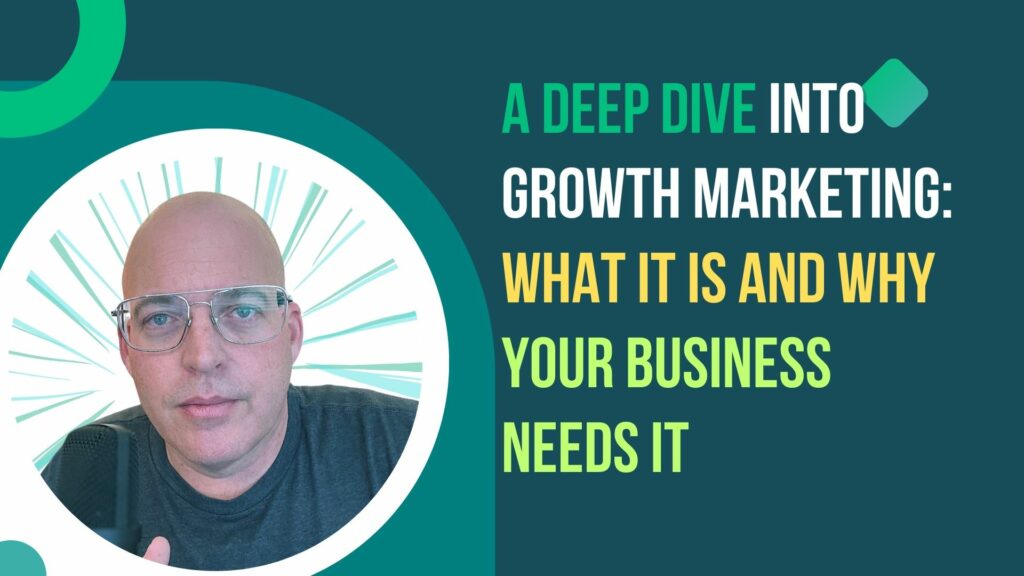Every company strives to achieve growth and success in today’s fast-paced business landscape. However, launching a product or service is not enough to guarantee success.
Businesses must adopt a systematic approach that focuses on continuous experimentation and optimization. This is where growth marketing comes into play.
Using data-driven techniques, growth marketing is an innovative approach to drive engagement, customer retention, and revenue growth. Unlike traditional marketing, which relies on one-size-fits-all strategies, growth marketing adopts a more personalized approach tailored to each customer’s needs.
The Importance of Growth Marketing in Today’s Business Landscape
Consumers are inundated with countless ads and messages from various brands. As a result, it has become increasingly difficult for businesses to stand out from the crowd and attract new customers. This is where growth marketing can make all the difference.
Businesses can accurately identify their target audience’s needs and preferences by leveraging data insights and analytics tools. This information enables them to create more effective campaigns that resonate with their customers’ desires.
Moreover, businesses can refine their campaigns for maximum impact by adopting a continuous experimentation mindset. Stay ahead of the competition while building long-term customer relationships.
What Is Growth Marketing?
Growth marketing is an iterative process that involves testing various tactics until you find what works best for your business. It consists in experimenting with different channels such as social media platforms (Facebook Ads), email campaigns (MailChimp), SEO (Search Engine Optimization), and CRO (Conversion Rate Optimization), among others.
At its core, growth marketing is about understanding your customers’ needs and delivering value at every stage of their journey. It’s about tracking metrics, testing campaigns, and refining your approach until you achieve the desired results.
Growth marketing is a holistic approach that combines creativity, data analysis, and experimentation to drive revenue growth. By focusing on each customer’s unique needs and adopting a personalized approach, businesses can achieve long-term success while building strong relationships with their target audience.
The Foundations of Growth Marketing
Understanding the Customer Journey and How it Relates to Growth Marketing
To succeed at growth marketing, you need to understand your customers. Their needs, goals, and pain points should be in your mind as you develop your strategy. Understanding the customer journey is a critical component of this process.
Your customers’ journeys will help inform how you structure your growth strategy. You need to know what triggers them to start looking for a solution (awareness stage), what they consider as options (consideration stage), why they choose one solution over another (decision stage), and how they feel about their choice after trying it out (post-decision evaluation).
Understanding each step of the customer journey allows us to create content speaking directly to these various stages. This approach will help build trust with potential customers because it shows that you understand their needs and are there for them every step of the way.
Setting Goals and KPIs for Growth Marketing Efforts
One of the biggest mistakes businesses make in growth marketing is not setting clear goals or key performance indicators (KPIs) before launching their campaigns. Without specific goals in mind, it’s impossible to measure success or optimize campaigns effectively. When setting goals, be realistic but ambitious. What do you hope to achieve with your growth marketing efforts?
Do you want more website traffic? More leads? More sales? Set measurable targets that align with your overall business objectives.
Once you have defined your goals, it’s time to identify key performance indicators (KPIs) to help track progress toward them. When selecting KPIs, focus on the metrics that matter most for achieving success based on your business objectives.
Understanding the customer journey and setting appropriate goals and KPIs are foundational to creating an effective growth marketing strategy. If you skip these steps, it’s like building a house without a strong foundation – it will eventually collapse.

Strategies for Growth Marketing Success
Developing a Comprehensive Content Strategy
Content marketing has become an indispensable part of any growth marketing strategy. It involves creating and distributing valuable, relevant content to attract and retain a clearly defined audience.
The goal is to drive profitable customer action by providing helpful information that educates or entertains the target audience. A comprehensive content strategy starts with understanding your target audience’s pain points, interests, and preferences.
Create content that resonates with them emotionally and intellectually. Your content should be diverse in format (e.g., blog posts, videos, infographics) to cater to different learning styles and preferences.
It’s essential to track the performance of your content using tools like Google Analytics or HubSpot Analytics. This will help you understand content types that resonate with your audience and adjust your strategy accordingly.
Leveraging Social Media Platforms for Growth
Social media has revolutionized businesses online. Platforms like Facebook, Instagram, Twitter, and LinkedIn have become essential tools for reaching new audiences, engaging with customers, and building brand awareness.
It’s critical to have a clearly defined social media strategy tailored to each platform’s strengths. For instance, Instagram is great for visual storytelling, while LinkedIn is ideal for building professional networks.
It’s also essential to monitor social media metrics like engagement rates (likes or comments per post), reach (the number of people who see your posts), and click-through rates (the percentage of people who click through to your website). This data will help you optimize your social media strategy over time.
Utilizing Emarketing Campaigns to Drive Conversions
Email marketing campaigns are a way to drive conversions in growth marketing today. They are personalizable at scale and can be automated to target different segments of your audience at various stages of the customer journey.
To effectively utilize email marketing campaigns, you must build a high-quality email list by offering incentives like free trials or lead magnets. Once you have a list, segment it based on critical criteria like location or purchase history to send targeted messages that resonate with each group.
It’s also essential to test and optimize each element of your email campaign, including subject lines, copy, images and calls to action. This will help you improve conversion rates and ensure your emails remain relevant and valuable to your audience.
Developing a comprehensive content strategy is critical for growth marketing success. Leverage social media platforms strategically to reach new audiences and engage with customers.
Utilize email marketing campaigns effectively by building high-quality lists and segmenting them based on critical criteria. By following these strategies, you can achieve significant growth for your business in today’s digital landscape.
Conversion Rate Optimization (CRO)
Why Conversion Rate Optimization is Crucial to Growth Marketing Success
In today’s digital age, businesses constantly compete for attention and conversions. With the vast number of options available to consumers, ensuring that your website and marketing strategies are optimized for conversion is more important than ever.
CRO is improving the percentage of website visitors who take the desired action. CRO should be essential to any growth marketing strategy because it can help businesses improve their ROI without spending more on advertising.
Businesses can increase conversions and ultimate revenue by optimizing existing traffic through A/B testing and other techniques. However, implementing CRO requires patience and persistence as it involves continuous experimentation and iteration.
Implementing A/B Testing Strategies for Maximum Results
A/B testing is one of the most effective ways to optimize conversion rates in growth marketing. Create two versions of a webpage or element within a webpage (such as headlines or call-to-action buttons), with only one variable being different.
Visitors are then randomly directed to see either version A or version B, allowing you to compare which version performs better in conversions. When implementing A/B testing strategies, it’s essential to ensure that only one variable is changed at a time so that you can accurately track which change has led to an improvement in conversion rates.
Additionally, it would help if you were sure to test each variation for an extended period to gather enough data for statistically significant results.

Search Engine Optimization (SEO)
The Critical Role SEO Plays in Long-Term Growth Success
In today’s digital landscape, SEO is more important than ever. By ranking higher in SERPs, businesses can drive organic traffic to their website, ultimately increasing conversions. A strong SEO strategy should be considered essential to any growth marketing plan. This is because the benefits of SEO often compound over time, with the initial investment leading to long-term gains in traffic and revenue.
Best Practices for Optimizing Your Website and Content for Search Engines
Businesses can follow many best practices when optimizing their website and content for search engines. These include conducting thorough keyword research. The process identifies terms and phrases, creates high-quality content that answers these queries meaningfully, and optimizes on-page elements. It’s also essential to stay up-to-date with changes to search engine algorithms, which can significantly impact your website’s ability to rank well in SERPs. Regularly monitoring industry news and updating your SEO strategy will help ensure your business remains competitive in search rankings over the long term.
Paid Advertising Strategies
The Many Benefits of Paid Advertising Within a Growth Marketing Strategy
While organic traffic is essential to any growth marketing strategy, paid advertising can be an effective supplement or alternative. Pay advertising has many benefits, including targeting specific audiences based on demographics or interests, increased visibility in search engine results pages (SERPs), and greater control over messaging than organic methods allow.
Paid advertising can take many forms within a growth marketing strategy. Some popular options include pay-per-click (PPC) ads on search engines or social media platforms, display advertising on relevant websites or through retargeting campaigns, and social media ads that appear in users’ newsfeeds or stories.
Exploring Different Types of Paid Advertising and When to Use Them
Many types of paid advertising are available to businesses, each with unique benefits and drawbacks. For example, businesses targeting a younger demographic may succeed with social media ads on platforms such as Instagram or Snapchat. Conversely, B2B companies may grow with PPC ads on search engines like Google. Display advertising can be effective for increasing brand awareness among a wider audience. The best approach will depend on unique business goals and needs.
Rarely Known Small Details: Tips and Tricks for Growth Marketing Mastery
Too often, businesses think growth marketing is just about creating content and running campaigns. But so many small details can make a big difference in your success. One of the most important is understanding the psychology behind consumer behavior.
By learning how people think and what motivates them, you can create content that resonates and campaigns that convert. Another key detail is paying attention to timing.
You might have the best content in the world, but it won’t be effective if you’re not publishing it at the right time. Timing applies to all aspects of growth marketing – from social media posts to email campaigns.
Make sure you publish when your target audience is likely to be online. Don’t forget about the power of storytelling.
People connect with stories deeply, so incorporating them into your content can help build relationships with your audience. Whether telling stories about your brand or sharing customer success stories, weaving narratives into your growth marketing strategy can significantly impact you.
Tracking Metrics and Analytics
In today’s data-driven world, tracking metrics and analytics are essential for growth marketing success. But too often, businesses look at vanity metrics like page views or social media likes instead of focusing on metrics like conversion rates or customer retention. One important metric to track is bounce rate – how many people leave your website after only viewing one page?
A high bounce rate could indicate problems with usability or site speed – both of which will hurt conversions. Another metric to track is the customer lifetime value (CLV).
This tells you how much revenue a single customer will generate over their lifetime as a customer of your business. Increasing CLV through upselling or cross-selling allows you to maximize revenue without acquiring new customers.
But tracking metrics is just the first step. Analyzing them and using those insights to improve your growth marketing strategy is also essential.
The Importance of Tracking Metrics and Analytics in Growth Marketing
Tracking metrics and analytics is crucial in growth marketing. Without this data, you’re essentially flying blind – making guesses about what might be effective without any objective evidence to back it up. You can identify what’s working and what isn’t – allowing you to adjust your strategy accordingly.
And over time, as you collect more data, you can start making more informed predictions about which tactics will most effectively achieve your growth goals. But it’s not just about tracking numbers for the sake of it.
The real value of metrics lies in using that information to improve your strategy and drive results. Whether optimizing content or refining email campaigns, you can continuously improve your growth marketing efforts using analytics effectively.
Business Strategies for Growth
Growth marketing is essential to any successful business strategy – but only if done right. By focusing on critical details like consumer psychology, timing, and storytelling while also obsessing over analytics and tracking relevant metrics like CLV and bounce rate, businesses can create a solid foundation for long-term success. But at its core, growth marketing is about experimentation and testing.
By constantly trying new tactics and analyzing the results, businesses can refine their approach over time – leading to more efficient campaigns that drive meaningful results. So don’t be afraid to try new things or go against conventional wisdom – because sometimes the unpopular opinion is the key to unlocking true growth potential.








